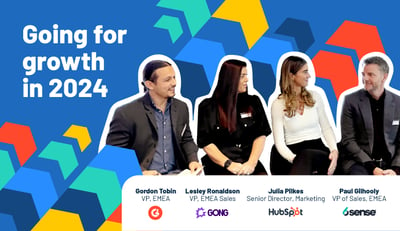September 4, 2025
 by Tanushree Verma / September 4, 2025
by Tanushree Verma / September 4, 2025
-1.png?width=1480&name=Featured%20image%20for%20Latane%20Conant%20Q%26A%20(4)-1.png)
The days of sending hundreds of cold emails to prospects are long gone. Mass outreach without personalization is as outdated as last season’s LinkedIn growth hacks.
Why? Because today's B2B buyers are drowning in a tsunami of generic outreach. Without personalization, response rates to cold outreach are tanking, and conversion rates for many are hitting rock bottom.
However, many brands have figured out new ways to drive open rates and engagement by leveraging personalization in their outreach. All without manually touching a single email.
To learn more about how sales professionals can better leverage personalization in their outreach, I recently sat down with Latané Conant, Chief Market Officer of 6sense, and she answered some of my most pressing questions.
What separates the pipeline pioneers from the outreach obituaries? What does it actually take to move from spray-and-pray to surgical strikes that convert? And how are the top performers using AI to create what some call an "autonomous pipeline"?
This interview is part of G2’s Industry Insights series. Discover more game-changing insights here, or watch the full interview below:
Latané, as the current Chief Market Officer and former CRO at 6sense, you’ve had a front row seat to how the salestech landscape has evolved and how revenue teams conduct outreach. Can you describe how sales outreach has evolved over the past few years and what's driving this shift away from mass outreach to a more targeted approach?
The inbox is incredibly cluttered now, with everyone constantly crowding it. This means a couple of things for sales and marketing teams.
First, they need to think multi-channel — treating the inbox like an impression and ensuring you're using multiple channels like phone, digital, and others.
Second, you also need to be much more personalized to stand out. I focus on context over personalization.
When most people hear "personalization," they think about knowing someone's industry or seeing they live in Massachusetts and assuming they like a particular baseball team. That's not real personalization.
Latané Conant
Chief Market Officer at 6sense
Context is understanding a company's business objectives. The good news is that these contexts and behavioral signals are more accessible than ever. Amassing intent data is table stakes at this point. Any good B2B sales and marketing team needs it.
Context also comes from gathering other signals, like job changes, funding announcements, and similar events, to get the timing right. It's about both the message and the timing of your outreach. We've all gotten emails we would never have responded to three months ago, but then something changes, and suddenly it piques our interest.
What are the specific results you've seen from using a highly personalized approach in your outreach?
When we look at our outreach, the difference between an email that's 50% personalized and 60–70% personalized is double the response rate—literally double! An email really needs to be more than 60% personalized for it to even matter. We track the percentage of personalization in emails as one of our key KPIs.
Personalization also goes back to behavioral signals and intent data, and using those to derive how you should personalize the email. Also, personalization isn’t important just for sales; it’s also important in marketing. The same principles apply to personalization in ads and on landing pages. At 6sense, even what I would call minimal personalization in our landing page forms and copy, such as industry and company size, gets us a 40% lift in conversion.
The key is making sure the segment or audience drives the message behind your content.
What makes behavioral targeting essential in today's market?
Automated solutions have lowered the overall cost of outreach, but they have also increased the amount of spam that prospects encounter. It all comes back to the amount of noise in the market. And so, behavioral targeting is essential.
Today, we have this new opportunity with large language models (LLM) and GenAI to get better signals in real time and take those signals to architect them into outreach. Imagine a world where every single touchpoint is developed almost in real time for that specific person!
Of course, in B2B, it's more complicated because you're not just personalizing for a person. You're personalizing for the person, their persona (their role), and the role they play in a buying group. That's three levels versus in B2C, which is something you have to consider.
At 6sense, you're seeing AI transform pipeline development. What are the top AI use cases that are actually moving the revenue needle for your team right now?
25% of our pipeline is created autonomously. Ideally, like autonomous driving cars, we want an autonomous pipeline — the ability to go from a signal to a meeting getting booked in minutes.
We've been able to amass the right signals and create workflows around them. These workflows personalize outreach, determine which channel and tactic to use, and ensure data is accurate and up-to-date. It's multiple mini workloads that we make easy to string together.
Some specific examples for use cases include:
Our customers have success with other use cases, like event follow-up and cross-sell initiatives, using signals that show companies are in-market for alternative products.
The critical aspect is the workflow — making it easy to put together. We released a product in March that makes it drag-and-drop simple for customers to design workflows from account to persona to person to buying group across any channel and signal.
Traditional ideal customer profiles (ICP) were often set-and-forget documents. How is AI enabling the continuous refinement of ICPs?
We've been using AI for a long time with predictive models. The key is dynamic segmentation. You need infrastructure that isn't just pushing lists around, but truly creates dynamic audiences.
The first step is being able to create a foundational dynamic audience. Step two is identifying unique signals that match your ICP and your in-market ICP.
G2 is a great example of this. I might have a dynamic segment of ideal accounts from a firmographic and demographic perspective, but are they ready to buy? Maybe not. But if they're researching me, my competitors, the category, or alternatives, that transforms them from an account I'm interested in to an account I need to reach out to today.
The process involves dynamic segments, layering in behavioral data, and ensuring you have the right service level agreements (SLA) and processes to follow up on behavior. I see many companies with intent data and other tools, but it dies on the vine.
Bottom line: You need SLAs, automation, or GenAI agents — whatever it takes to go from signal to meeting in minutes, not weeks or years. That orchestration is critical.
How do you prevent precision targeting from becoming too narrow? What guardrails do you put in place to ensure you're not missing emerging market opportunities?
There are several ways to address this. When it comes to advertising, if your audience is too narrow, it's difficult to get media placed. We have alerts that flag if and when your audience size might be too small in order for you to use the targeting you need.
The more flexibility you have to launch and iterate campaigns, the better, because experimentation is key. Having pre-built workflows also lets you try an audience, and if you realize it's too small, you can quickly adjust it accordingly.
AI can also help here because it recognizes patterns faster than humans can. You want a model that's always working to uncover different patterns, looking for accounts that might have the same behavioral pattern as your ICP, and then dynamically bring them into your audience. If you set up dynamic segmentation that's always on, you should constantly find new accounts, personas, and people to add to campaigns.
For someone just starting this transition into targeted outreach, what's the first step? How do they begin moving to more precision targeting in the age of AI?
Start with the "who." As marketers, we often get excited about cool tactics or what competitors are doing, but that's not where you start. You start with understanding your audience.
I'm guilty of this myself. I'll get excited about an Instagram play or partnership because it sounds cool, but I have to stop myself. Our audiences are sales and marketing teams, many on social media, and we want to reach marketing ops and digital personas. I knew the "who," but I was more excited about the "what" and "where" than the "who."
You need to be most excited about the "who" first. Once you nail that, the "what" and "where" become obvious. This helps avoid wasting money on campaigns that sound cool but won't deliver return-on-investment (ROI).
Challenge yourself when you see competitors doing something and think, "We need to do that." Take a beat. Not all competitors sell to the same audience or offer the same value proposition.
Intent data is table stakes now for any brand that wants to understand their audience and target in-market buyers. Review sites are absolutely critical if you want to access deeper intent data and insights. Without them, you risk spending lots of time getting reviews, but have no visibility into who is reading those reviews.
You need to know exactly who's on your website. When only 3% of website visitors fill out forms, and you've spent money getting those people to your website, you need to identify them easily.
Then you can layer on third-party intent (keywords) and behavioral signals we discussed earlier, like job changes, funding information, and more. Really amassing this data will make every tactic you use work exponentially better.
Want to learn more about how to better personalize your outreach with intent data? Check out our recent webinar with HubSpot here.
Follow Latané Conant on LinkedIn to learn more about revenue growth with the power of AI.
Edited by Supanna Das
Tanushree is an Editorial Content Specialist at G2, bringing over 3 years of experience in content writing and marketing to the team. Outside of work, she finds joy in reading fiction and indulging in a good rom-com or horror movie (only with friends). She is an enthusiastic dancer, a lover of cat reels, and likes to paint. A dedicated Swiftie, Tanushree also has a deep love for Hindi music.
B2B marketing and selling have not been able to keep up with changes in buyer preferences....
 by Kerry Cunningham
by Kerry Cunningham
It’s time to tell the market, “It’s not you. It’s me.” Like, for real.
 by Alexandra Vazquez
by Alexandra Vazquez
Growth. It’s the topic every sales and marketing leader is focused on right now. We’re coming...
 by Gordon Tobin
by Gordon Tobin
B2B marketing and selling have not been able to keep up with changes in buyer preferences....
 by Kerry Cunningham
by Kerry Cunningham
It’s time to tell the market, “It’s not you. It’s me.” Like, for real.
 by Alexandra Vazquez
by Alexandra Vazquez


